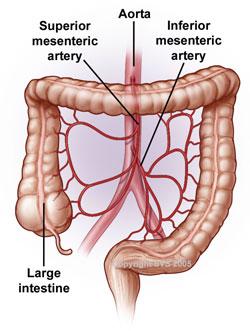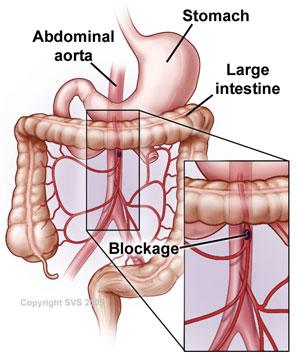Mesenteric ischemia is poor circulation in the vessels supplying blood flow to your mesenteric organs: your stomach, liver, colon and intestine. With poor circulation, blockages can form and compromise the function of these organs.
Can Be Acute or Chronic
The information contained on Vascular.org is not intended, and should not be relied upon, as a substitute for medical advice or treatment. It is very important that individuals with specific medical problems or questions consult with their doctor or other health care professional.

- Sudden, Severe Stomach Pain: Acute mesenteric ischemia can cause sudden, severe stomach pain, sometimes with nausea or vomiting.
- Severe Stomach Pain After Eating: Chronic mesenteric ischemia often causes severe stomach pain 15–60 minutes after eating. The pain may last for as long as 2 hours and, unfortunately, tends to recur with every meal. You may also experience nausea, vomiting, diarrhea or flatulence.
- Weight Loss and Loss of Appetite: Chronic mesenteric ischemia sometimes leads you to lose weight because, although you may feel hungry, you eat less or less frequently to avoid the pain.
Acute mesenteric ischemia is commonly caused by a blood clot, which travels to one of the mesenteric arteries and suddenly blocks blood flow. These clots often originate in the heart and are more common among patients with an irregular heartbeat or heart disease.
Chronic mesenteric ischemia is frequently due to atherosclerosis (hardening of the arteries), which slows the amount of blood flowing through the arteries. An artery becomes blocked by plaque, which is formed by fats and other materials circulating in your blood. As more plaque builds up along the blood vessel wall, the artery can narrow and stiffen. Eventually, enough plaque builds up to reduce blood flow or even completely block the arteries.

See a Vascular Surgeon
If you have the symptoms outlined above, see a vascular surgeon. You will be asked about your history of smoking, high blood pressure, diabetes and heart disease, and details about when and how often the symptoms occur and how long they last. The vascular surgeon will also perform a physical exam.
Tests May Be Recommended
A Doppler ultrasound, a CT angiogram (CTA), or an angiogram may be recommended.
A computed tomography (CT) scan is the test of choice. A CTA creates detailed three-dimensional images from X-rays taken of cross-sections of your body. These images can identify problems with your arteries or with your abdominal organs.
An angiogram (also called an arteriogram) is a more invasive test but may be preferred if a rapid diagnosis is very important. This test uses X-rays to view your blood vessels.
The goal of treatment for mesenteric ischemia (both chronic and acute) is to re-open the artery to allow adequate blood flow to your intestine so it will work properly. This must be accomplished before permanent damage is done. The specifics of your condition will guide your vascular surgeon on whether to recommend treatment on an emergency or elective (scheduled procedure) basis.
In Acute Cases:
- Narcotic pain medications may be given to alleviate severe pain.
- Treatment is usually an emergency procedure since severe intestinal damage can occur rapidly.
- If a clot is found early, your vascular surgeon may recommend percutaneous thrombectomy or thrombolytic therapy. This treatment involves sucking out the clot from within the artery or injecting clot-dissolving medication into the blood vessel. It is often given at the same time as a diagnostic angiogram.
- If there is evidence of intestinal damage or too little time is available for percutaneous treatment or for the thrombolytic agent to work, open surgery may be needed to remove the clot and restore blood flow to your intestinal arteries.
- Some patients require surgery to remove damaged portions of the intestine. This is a decision your vascular surgeon will make, often in conjunction with other surgical specialists.
In Chronic Cases:
- Minimally invasive endovascular treatment has become the first-line approach in most instances. Balloon angioplasty and stenting are sometimes performed at the same time as a diagnostic angiogram to avoid a second procedure and begin treatment as soon as possible. A tiny balloon device is inserted inside the narrowed artery. Your vascular surgeon inflates and deflates the balloon to push plaque against the wall of the artery. Once the artery is widened, your vascular surgeon inserts a stent, a tiny metallic mesh tube designed to support the artery walls to keep the vessel open.
- If you are not a candidate for angioplasty and stenting, bypass surgery is recommended. The vascular surgeon creates a detour around the narrowed or blocked section of the affected artery. To create the detour, one of your veins or a synthetic tube is used as a graft, sewn-in above and below the blocked area to restore adequate blood flow to your intestines.
- Follow a heart-healthy diet.
- Avoid smoking. If you do smoke, ask your vascular surgeon to help you find a smoking cessation program that will work for you.
- Exercise regularly.
- Stay hydrated.
- Manage chronic medical conditions including diabetes, high blood pressure, kidney failure and heart disease.
